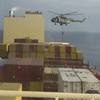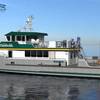The evolution of a new offshore boat design ideally happens with considerable customer input. But in the case of Bollinger Shipyards' new 220-ft. class supply vessel, a fortunate coincidence happen. The first customer for the new vessel, C&G Boats, Golden Meadow, La., and Bollinger independently evolved a vessel with many of the same design features.
"When we decided that we needed a new, more capable supply boat, we rejected many conventional designs because they did not have what our customers told us they wanted," said Joey Arceneaux, president of MNM Boats, the operating division of C&G Boats, Golden Meadow, La.
Arceneaux said he talked to many independent and contract drillers as well as the major oil companies and the ability to hold large volumes of liquid mud were a critical feature for these drilling companies. "Not only the ability to hold large volumes of liquid mud was important, but the flexibility to hold two or three different weights or types of mud without cross-contamination was critical," Arceneaux said.
"The drilling companies are now drilling very deep wells in relatively shallow water, so they need more mud per well and even two or three different types of mud as the drilling progresses to very deep wells, "Arceneaux added. The wells are now 22,000 to 25,000 ft. deep in many sections of the shelf according to Al Cheramie the "C" in C&G and one of the pioneers in the offshore oil and gas business.
At the same time Scott Theriot, executive vice president and manager of new construction for Bollinger and his engineering staff were also talking to their customers, the vessel operating companies, about a larger vessel following on to their extremely successful 145-ft. utility/supply boat design. "We knew we were not simply going to stretch our 145-ft. hull and call it a new vessel," Theriot said. "During our market research we talked to C&G Boats and found that their ideas for a new vessel design closely paralleled our own research," Theriot added.
The more C&G Boats and Bollinger talked, the more a new design for a "super shelf" boat crystallized. Both companies knew that there was no need to build a 260-ft. boat to get the mud hauling capacity they needed for shelf work. "Far too many of these big boats are going out 25% loaded anyway," Cheramie said. "A few are even making grocery runs," Cheramie said shaking his head.
What finally evolved from the C&G and Bollinger collaboration was a 207-ft. by 53-ft. vessel with a 19-ft. hull depth. In the hull are six liquid mud tanks with a total capacity of 6,241 barrels.
To meet the customer need of carrying different types of mud, Bollinger designed three separate pumping and piping systems so three types of mud could be offloaded without contamination.
The liquid mud tanks are located port and starboard with five spherical bulk mud tanks separating them along the keel of the boat. The bulk mud tanks hold 6,000 cu. ft. of dry bulk material and feature two separate piping and pumping systems enabling the vessel to carry and offload two types of dry bulk product.
"Being able to carry over 6,000 barrels of liquid mud and 6,000 cu. ft. of dry bulk material definitely puts this new vessel in a 220-ft. class or longer," Theriot said.
The ability to carry and deliver large amounts of liquid and dry bulk material impacts the design of other systems on the boat. For example, dynamic positioning capability is a must when working around a rig for several hours. "Oil companies get very nervous about the safety of the transfer operation without DP equipped vessels and that was another major design criteria of ours," Arceneaux said.
The new vessels have installed an IVCS 2000 supplied by Beier Radio, Harvey, La. The system is rated DP-1 by ABS. "For our customers needs, a DP-1 system will hold the vessel wherever we want it," Arceneaux reported. The added expense of a DP-2 system only to get redundancy was not warranted in the shallower water that C&G's customers operate.
To power these vessels, Bollinger engineers chose Caterpillar diesel engines supplied by Louisiana Machinery, Belle Chasse, La. "We chose a conventional propulsion system for these new vessels," Theriot reported. Main propulsion power is supplied by a pair of Caterpillar 3515B engines producing 2,000 hp each at 1,600 rpm. A pair of Reintjes gears transfers power to a pair of Bollinger-built stainless steel propellers and shafts. The propellers are 102-in. in diameter.
"We completely concurred with Bollinger's choice of main propulsion," Cheramie said. "Working with Z drives can be a problem especially in shallow draft ports where the Z-drives act as vacuum cleaners sweeping everything off the sea bed and into the drive," Cheramie said. Foreign material often gets caught between the drive propeller and the kort nozzle, according to Cheramie.
Other propulsion engines include a Caterpillar 3412C to operate the 700 hp SMI bowthruster and a Caterpillar 3408 engine to power a 400 HP SMI stern thruster. The bowthruster engine also powers a PTO that drives a Crane Demming 8x6 fire pump supplying 1,900 gpm of water to a Stang fire monitor.
The electrical power generation on this new series of supply boats is via a pair of Caterpillar 3408 engines each fitted with 370 KW generators. The seventh Caterpillar diesel engine onboard is a 95 KW emergency generator.
The first vessel in this new series of supply boats by Bollinger is the Ms. Sara Jane for C&G Boats. The very first thing you notice when boarding the vessel are the six-ft. high bulwarks. "This is a very safe vessel as well as one offering state-of-the-art performance," said Neil Verett who is the project manager for these vessels. 'The high bulwarks offer an enhanced degree of safety for the crew when working on the cargo deck in high seas," Verett added.
The cargo deck is 145 ft. long and 45 ft. wide yielding a clear area of 6,525 sq. ft. that can carry 1,380 long tons. "C&G has opted for four-inch thick boards, rather than the standard two inch," reports Verett. 'This not only offers additional protection the steel deck beneath but should result in the boards being replaced less often," Verett added. In addition to the high bulwarks and thicker deck boards, all of the piping and vents above the cargo deck are stainless steel for freedom from corrosion.
With a total deadweight carrying capacity of 2,278 long tons the vessel has the capability for considerable below deck liquid storage in addition to liquid and bulk mud. Transferable liquids include 235,183 gallons of drill water, 157,153 gallons of fuel oil and 37,302 gallons of fresh water.
Ship's liquids include 2,876 gallons of lube oil, 423 gallons of gear oil, 1,470 gallons of hydraulic oil, 2,653 gallons of sewage, and 1,428 gallons each of dirty oil and oily bilge.
Speed of the vessel is 11.5 knots maximum which is about one knot faster than other large OSVs of similar capacity. "The double chine hull design along with the bilge keels and rolling chocks all contribute to the speed of this vessel and its stability," said Theriot. "We do not have to use main deck flume tanks that use deadweight tonnage that can other wise be used for cargo or below deck liquids," Theriot added. Recessed keel coolers also smooth the water flow over the hull, Theriot said.
The main deck of the superstructure has a crew lounge and the galley and mess area immediately aft of the forepeak Off of the galley is a space for dry provisions and a walk-in cooler and walk-in freezer. Heads, the laundry room and two crew cabins are also on this level. On the Focsle deck are additional crew accommodations, heads and the emergency generator room. Totally, there are six crew cabins with 22 berths. A 36-person Red Fox Marine Sanitary device is onboard for waster treatment.
The pilothouse is outfitted with the latest high-tech electronics for communications and navigation along with touch screen monitoring and alarm systems. As noted earlier, Beier Radio supplied the IVCS DP-1 system that feeds the inputs from a pair of wind birds, a Furuno GP-31 GPS unit, a Robertson gyrocompass and a vertical reference sensor into a computer that outputs data to input/output sensors that control the thrusters and propellers and directly control the rudders.
This system allows the vessel operator to maneuver, dock or hold position manually via a joystick or automatically with pushbuttons.
An area A3 GMDSS suite handles the communications onboard the vessel and consists of two Standard Horizon VHFs, a MF/HF unit and a satellite communications system.
Beier Radio also supplied the alarm and monitoring system. This system does much more than replace the banks of warning lights that were the backbone of earlier alarm systems. Alarm data is shown on a computer screen in real time. More importantly, touch screen technology allows the vessel operator to monitor and control the flow of materials being transferred to the rig such as bulk mud, liquid mud and fuel oil. Each of these systems has a dedicated graphics page such as shown in figure one that mimics the six liquid mud tanks and its pumps and piping.
Video display units for the alarm and monitoring system are located in the engine room, forward and aft bridge consoles and the Chief Engineer's Stateroom. .
The Ms. Sara Jane will be delivered to C&G Boats in October with the second vessel Ms. Jolie following by the end of the year.
Bollinger has seven other 207s under contract with additional orders anticipated.
Sponsored Content
Chris-Marine’s solutions help to prolong engine lifetime

Subscribe for
Maritime Reporter E-News
Maritime Reporter E-News is the maritime industry's largest circulation and most authoritative ENews Service, delivered to your Email five times per week












